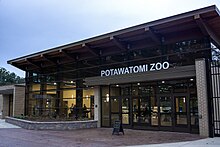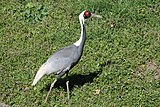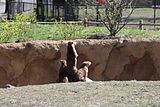Potawatomi Zoo
 Entrance | |
| Date opened | 1921 |
|---|---|
| Location | South Bend, Indiana, United States |
| Coordinates | 41°40′09.59″N 86°13′04.52″W / 41.6693306°N 86.2179222°W |
| Land area | 23 acres (9.3 ha)[1] |
| No. of animals | 400[1] |
| Memberships | AZA[2] |
| Website | www |
The Potawatomi Zoo is a 23-acre (9.3 ha) zoological park located in South Bend, Indiana, United States. The Zoo is nestled in Potawatomi Park between the St. Joseph River and the Grand Trunk railroad in the east side neighborhood of River Park. Founded in 1921, it is Indiana's oldest Zoo. It features over 400 animals and is accredited by the Association of Zoos and Aquariums.[3] The zoo has over 200,000 visitors each year.
History[]
The South Bend Zoo began as a modest duck pond in Leeper Park in 1902.[4] In 1921, the Potawatomi Zoo was established in Potawatomi Park and a single deer was donated by Albert Russell Erskine, then president of the Studebaker Corporation.[5] As the oldest zoo in Indiana, today's 23-acre Potawatomi Zoo is rich in history and building a promising future.
At the end of the Great Depression in 1940, the Works Progress Administration constructed the zoo's Cat House, its first permanent structure. The building still stands, serving as home to Amur leopards and snow leopards, and is the oldest zoo building still standing.[6]
The list of species housed at the zoo in 1947 included a polar bear, African lions, dwarf zebu, rhesus monkeys, peacocks and the less exotic raccoon.
In 1971, the St. Joseph Zoological Society, now called Potawatomi Zoological Society, was formed, with Craig D. McCowan as its first director. In 1981, the zoo began charging admission, to provide an accurate attendance count as well as revenue.[7]
The zoo was formerly operated and maintained by the South Bend Parks and Recreation Department. Since January 1, 2014, it has been operated and maintained by the Potawatomi Zoological Society,[8] while still remaining city owned.
The zoo opened its new front entrance in 2020. This beautiful gateway welcomes members and visitors and also houses the zoo's expanded gift shop.
Exhibits[]
The Potawatomi Zoo is home to over 400 animals and the zoo participates in over 56 Species Survival Plans.[9]
Africa[]
The Africa section spans much of the eastern third of the zoo. The Africa section begins with the Old World Monkeys exhibit which is home to black-and-white colobus monkeys and fennec fox (seasonal). In this part of the zoo you will also find southern ground hornbills, lions, plains zebra, Diana monkeys, African wild dogs, warthogs, greater kudu, and ostrich. In 2017, Potawatomi Zoo became the first accredited zoo in the state of Indiana to exhibit okapi, an endangered forest-dwelling relative of the giraffe. The zoo is home to two male okapis, which are viewable in an outdoor exhibit as well as in their Okapi Conservation Center indoor habitat. In 2019, the zoo announced the arrival of a male southern white rhinoceros, Masamba, now permanently on exhibit next to the okapi. A new lion exhibit will begin construction in 2021-2022, in the area where chimpanzees were formerly exhibited; the zoo's remaining two chimps moved to Rolling Hills Zoo to live with a larger troop.[10]
Asia[]
The Potawatomi Zoo is home to numerous species that are native to parts of Asia but these exhibits are spread throughout the zoo rather than being in one section. Near the front gate on the east side of the zoo is the Amur tiger exhibit and the Sichuan takins. In 2014, a red panda and muntjac exhibit was added near the front gate on the western side.[11]
Australian Outback[]
In the middle of the zoo, the former Australian Outback exhibit allowed zoogoers to walk among emus, red kangaroos, grey kangaroos, and Bennett's wallabies. This exhibit also included a yellow-crested cockatoo, a brush-tailed bettong, honeyeaters, laughing kookaburras, and black swans. The Australian Outback was replaced by a giraffe's African savannah exhibit opening in Spring 2022.[12] Kangaroos and emus have relocated to a new exhibit in the southwest corner of the zoo across from the alligator habitat.
Cat House[]
The zoo's Cat House was its first permanent structure built during the Great Depression as part of the Works Progress Administration. The Cat House includes outdoor exhibits for a snow leopard and Amur leopards. The birth of rare Amur leopard cubs in the summer of 2016 was a big hit.
Learning Center[]
The Learning Center is located at the front of the zoo. It is home to many smaller animals and the Zoo's Admissions & Membership Department. Species on exhibit include genet, sand cat, two-toed sloth, golden lion tamarin, cotton-top tamarin, white-faced saki monkey, red-rumped agouti, squirrel monkey, green iguana, banded mongoose, treeshrew, Madagascar hissing cockroach, Texas brown tarantula, Goliath bird eating tarantula, Chilean tarantula, Emperor scorpion, Malaysian scorpion, vinegaroon, as well as various turtles, snakes, geckos, frogs, skinks and other reptiles and amphibians.
The Americas[]
The western half of the zoo is home to exhibits representing North and South America. A key feature of the Americas section includes the bison yard which is home to three American bison. In 2011, the zoo added a North American river otter exhibit in the Americas section. The otter exhibit utilizes a green roof, the first of its kind to be used on a municipal building in South Bend.[13] The Americas also includes Chacoan peccaries, bobcats, red fox, Eastern screech owl, red-tailed hawks, prairie dogs, American alligators, capybaras, giant anteaters, crested screamers, blue-and-yellow macaw, and green-winged macaw.
Zoo Farm[]
Pet and feed the animals in the Zoo Farm. Animals at the Zoo Farm include alpacas, goats, sheep, Jersey cow, donkeys, turkeys, chickens, and a pot-bellied pig.
Conservation[]
The zoo breeds endangered animals and participates in over 56 Species Survival Plan programs.[14] The zoo has had a number of successes including the breeding Chacoan peccaries,[15] Southern three-banded armadillos, and Amur leopards. Since 2007, Pearl (female amur leopard) has had nine cubs with the most recent two being born in 2016.[16] In 2019, the zoo announced the birth of two Sichuan Takins, a vulnerable species native to Tibet and parts of China.[17]
Other Attractions[]
Carousel: The Endangered Species Carousel opened in 2016. The ride features 18 hand-crafted animals, like zebras, lions, and leopards.[18]
Zoo Train: Take a ride on a historic CP Huntington electric train around the western half of the zoo.[19]
Gallery[]

A Bengal tiger (died 2015)[20] takes a nap at Potawatomi Zoo.

A white-naped crane at the Potawatomi Zoo in April 2012.

An endangered golden lion tamarin at the Potawatomi Zoo in April 2012.

A North American river otter display opened in 2011.

A North American porcupine at the Potawatomi Zoo in September 2019.
References[]
- ^ a b South Bend Parks and Recreation Department
- ^ "Currently Accredited Zoos and Aquariums". aza.org. AZA. Retrieved April 20, 2012.
- ^ "Potawatomi Zoo – Our Mission And History". Archived from the original on 2 March 2012. Retrieved 20 April 2012.
- ^ "About Us". PotawatomiZoo.com. Retrieved June 5, 2021.
- ^ "Minutes of the South Bend Board of Park Commissioners, Book 1, 21 May 1921
- ^ "Annual Report, Board of South Bend Park Commissioners", 1940
- ^ "A Look Back: Indiana's oldest zoo". South Bend Tribune. Retrieved 2019-05-03.
- ^ Lake, Rachel (December 24, 2013). "Zoological society to take over management of Potawatomi Zoo". Archived from the original on September 8, 2014.
- ^ "Visit South Bend". Retrieved 20 April 2012.
- ^ "Chimps Move to New Zoo". September 8, 2020.
- ^ South Bend Tribune. "Red pandas now being featured at Potawatomi Zoo in South Bend". Notre Dame Insider. Retrieved 2019-05-06.
- ^ "Big and Loud Campaign". Potawami Zoo.
{{cite web}}: CS1 maint: url-status (link) - ^ South Bend On. "Zoo's river otters get first municipal green roof". Retrieved 20 April 2012.[permanent dead link]
- ^ Potawatomi Zoo. "Conservation Efforts". Potawatomi Zoo. Retrieved 2019-05-03.
- ^ Semmler, Ed (May 10, 2021). "New Babies at Potawatomi Zoo..." South Bend Tribune.
- ^ WNDU. "Amur leopard cubs: Behind the scenes at the Potawatomi Zoo". www.wndu.com. Retrieved 2019-05-03.
- ^ Report, South Bend Tribune. "Second Sichuan takin kid born at Potawatomi Zoo". South Bend Tribune. Retrieved 2019-05-03.
- ^ WNDU. "Potawatomi Zoo's Endangered Species Carousel opens Saturday". www.wndu.com. Retrieved 2019-05-03.
- ^ Potawatomi Zoo. "Guest Amenities". Potawatomi Zoo. Retrieved 2019-05-03.
- ^ Gray, Amanda (April 1, 2015). "Potawatomi Zoo's White Bengal euthanized". South Bend Tribune. Retrieved April 11, 2015.
External links[]
 Media related to Potawatomi Zoo at Wikimedia Commons
Media related to Potawatomi Zoo at Wikimedia Commons- Official website
- Zoos in Indiana
- Tourist attractions in South Bend, Indiana
- Buildings and structures in South Bend, Indiana




